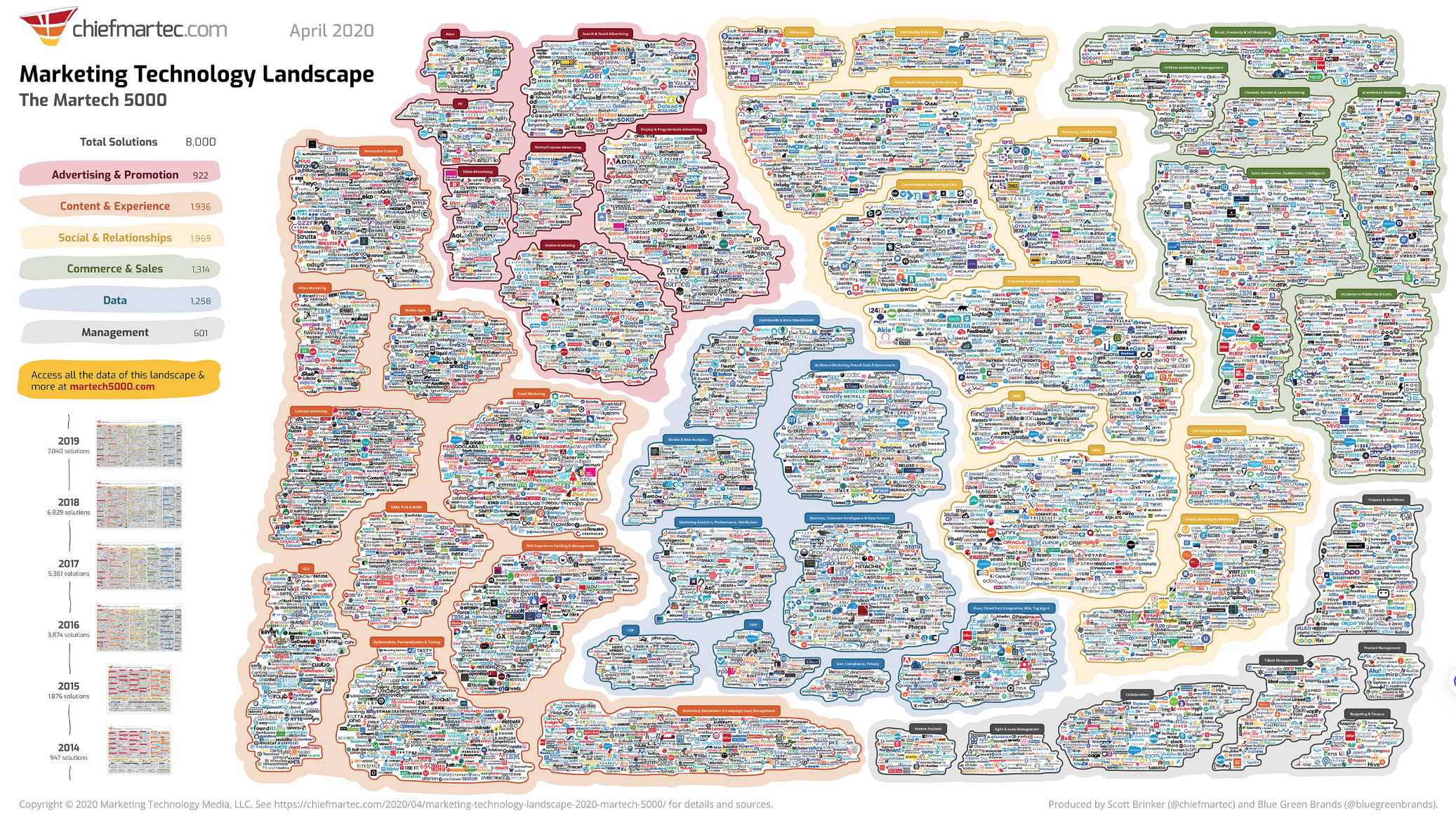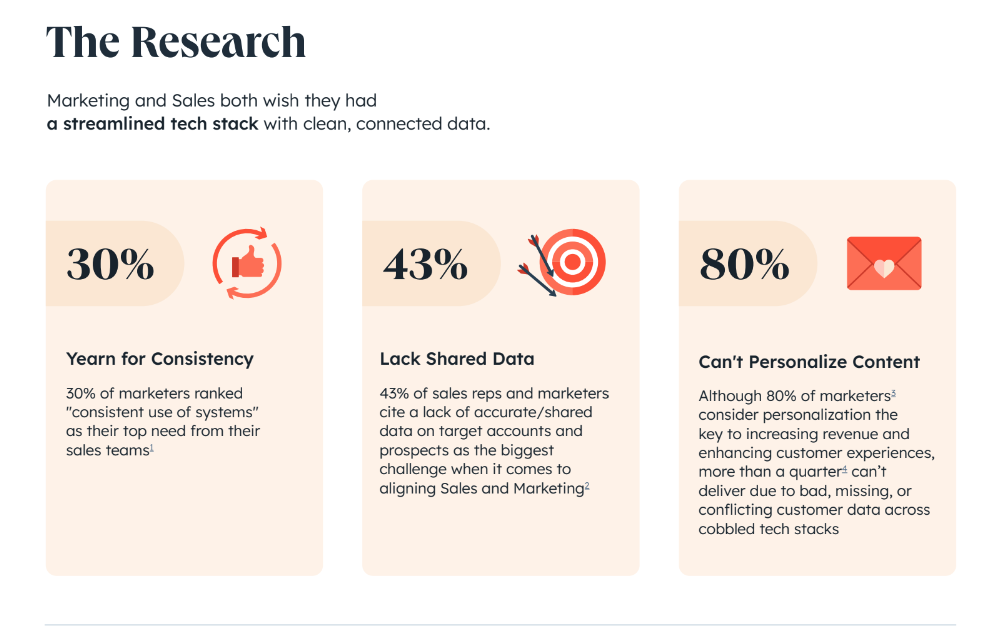Most companies are guilty of it. They continue adding to the tech stack until it's like a giant Jenga puzzle that just falls over of its own weight. Collecting every shiny thing that comes along with the promise of a better X, Y, or Z can be pretty tempting. And the options are almost endless with 8,000 different marketing technology (MarTech) solutions in the mix as of 2020.
Grow more with less may even seem daunting as a concept, but here's the rub: more isn't always better, and with technology, the hidden cost of lost time in learning, switching back and forth, and licensing and maintenance makes it even dicier.
The shiny object collection just keeps growing
The proliferation of Software as a Service (SaaS) tools in recent years has been remarkable. However, it is worth noting that the majority of companies utilize only a fraction, ranging from 10% to 20%, of the tools they acquire. Additionally, there is a significant amount of duplication among different vendors' offerings.
The real truth is: lots of the tech in use is either redundant or, even worse, isn't delivering any real ROI. Pictured below is the 2020 version of the MarTech 5000 (which has now ballooned to 8,000 and counting).

In 2023, streamlining is a smart play, especially if you can win on both the cost savings and sales-increasing outcomes.
The act of purchasing multiple tools amplifies the level of complexity involved in implementation, and when coupled with a shortage of expertise, it becomes an indulgence that only a limited number of companies can viably sustain.
The average salesperson may use 10 tools or more to complete a sale, and every navigation between tools is a loss of time, requires additional data entry, and results in the creeping degradation of the sales capacity. This same issue is occurring in multiple departments.
5 Steps to help your company grow less with more
Understand the platform approach.
Some key software providers have moved from being the purveyors to a few shiny objects, to functioning as a platform around key services. Two of these providers are Salesforce and HubSpot. The difference between limited set software and the platform approach is the recognition that you need to be able to easily integrate data, and other tools, but you will not have to leave the tool to do your work.
The key difference between platforms comes down to two elements. First, how easy it is to use? Will it be hard to get the team actively using? Second, does it integrate without the need for an administrator and hefty APIs?
Download a HubSpot Vs. Salesforce Comparison Guide
Focus on efficient workflows.
The most expensive part of your operation is time. The percentage of time that sales spend selling, customer service spends servicing, etc., is the efficiency and focus factor that will pay off. Software needs to support effective workflows not frustrate them.

Source: HubSpot research (2022)
Build around a single source of truth.
Two sources of truth (and most companies have many more than that) are one too many. You should be looking for:
- Unified contact records
- Data Sync
- Seamless integrations
Build collaboration, not isolation.
The tools that you use should help teams communicate as a customer-centric unit. Having teams capture information about customers or prospects in isolation does nothing to improve the customer experience. The lift of sharing historical data between departments can be massive and mostly doesn't happen.
>Try out a CRM that builds collaboration around a single source of truth
Major on the essentials.
To ensure that your plans for consolidation address fundamental business needs, focus on these steps:
- Assess current software usage: Evaluate the existing software landscape in your organization. Identify the tools and applications being used across different departments and teams.
- Determine critical business requirements: Understand the core functionalities and features necessary to support your business processes effectively. Identify the key needs and priorities of various departments and stakeholders.
- Analyze overlap and redundancy: Look for any overlapping functionalities or duplicate features among the software tools being used. Identify areas where consolidation can streamline operations and eliminate unnecessary redundancies.
- Prioritize key functionalities: Based on the critical business requirements and identified redundancies, prioritize the essential functionalities that need to be preserved or improved. Consider the impact on productivity, efficiency, and overall business goals.
- Involve stakeholders: Engage stakeholders from different departments and teams to gather their input and perspectives. Understand their specific needs and how the consolidation process can benefit their workflows.
- Evaluate integration capabilities: Assess the integration capabilities of the software tools you plan to consolidate. Ensure that they can seamlessly work together and share data to avoid any disruptions or data silos.
- Consider scalability and flexibility: Choose software solutions that not only meet the current requirements but also have the scalability and flexibility to accommodate future growth and evolving business needs.
- Plan the consolidation process: Develop a detailed plan for migrating and consolidating software tools. Consider the potential impact on users, training requirements, data migration, and any necessary customization or configuration.
- Test and validate: Before fully adopting the consolidated software, conduct thorough testing to ensure that the essential functionalities are working as expected. Validate the performance and compatibility of the consolidated tools.
- Provide training and support: Offer training sessions and provide comprehensive support to users during and after the consolidation process. Ensure that they are familiar with the essential functionalities and can maximize their utilization.
It can help to simply experience a unified customer-centric platform that doesn't require an expensive administrator and is easy to use with a massive list of turn-key integrations.
Try out a new CRM platform environment provided by HubSpot to see the difference.



